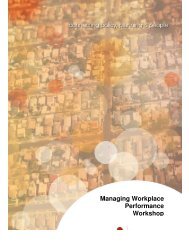adolescents highlight the effectiveness of working withyoung people from a strength-based model where it isacknowledged that:• Every individual, family, group and community hasstrengths, and the focus is on these strengths ratherthan pathology;• The community is a rich source of resources;• Interventions are based on client self-determination;• Collaboration is central with the practitioner-clientrelationship as primary and essential;• Outreach is employed as a preferred mode ofintervention; and• All people have the inherent capacity to learn, growand change. 18It is these elements of forming a relationship, preferablywith one person, being listened to, being respected forthe choices that have been made, and not being treatedas a “welfare” issue mean that young people are morelikely to access assistance and feel included both whilethey are pregnant and when they become parents.Bronfenbrenner’s socio-ecological model provides oneway of understanding factors that influence adherencewith clinic appointments. 19 The model posits that a child’sdevelopment/behaviour is influenced by interactions withothers (e.g. family), experiences in various settings (e.g.school, hospital) and larger systems (e.g. social/politicalclimate). Studies in other chronic illness groups regardingbarriers to clinic attendance have identified factors atthe micro and macro levels. For example, research hasshown a relationship between clinic attendance andindividual/developmental level factors such as forgettingand health beliefs. 20 Family factors including parentalsupervision regarding appointment-making have alsobeen identified. Interactions with the healthcare systemappear to also be a contributor to poor clinic attendance,including dissatisfaction with clinical care (e.g. poorcommunication, multiple physicians providing medicalcare), long waiting periods, and provider behaviours(e.g. explaining all components of the visit, answeringquestions). Furthermore, even the time of the appointmentcan influence clinic non-attendance, with adolescentsmissing fewer appointments in the afternoon comparedto the morning. Finally, societal and/or cultural factorsmay place adolescents at higher risk for non-adherencewith clinic appointments. For example, beliefs regardingmistrust of the healthcare system, socio-economic status(e.g. transportation issues, lack of insurance), presence/absence of social support, and past negative experienceswith medical teams play a key role in determining themotivation to attend routine appointments.62
Relevant research‘I felt like they were all kind of staring at me...’Antenatal education is important in preparing pregnantwomen for birth and parenthood, but one of the mostvulnerable groups, teenage mothers, is poor attendees.Lyz Howie and Caroline Carlisle report on a studyto investigate this group’s perceptions of antenatalclasses and what they consider would make them moreaccessible.Midwives magazine: July 2005IntroductionAntenatal education is part of the maternity culture,but teenagers are neither consistent nor committedattendees. 21 Few studies address the part antenataleducation plays in the delivery of parenthood preparation,sexual health, nutritional and educational issues. Due tothe above concerns, a descriptive study was undertakento discover the views of teenage mothers on antenataleducation and what they perceived their needs to be.MethodsThis study focused on teenagers aged 17 or under at thetime of delivery.Main studyThe aim was to explore what pregnant teenagerswant from antenatal education. The objectives were todetermine the information needs of teenage mothers,investigate the factors governing attendance or nonattendanceat antenatal education classes and explorethe views of attendees.FindingsSocio-demographics and birth perceptionsThe socio-demographic and socio-characteristic factorsof the teenagers were recorded. Comparisons of age,in relation to substance use, clearly show that as theteenagers in this study mature, uptake of substance useincreases.The teenagers’ perceptions on issues associated withtheir birth were considered. They were asked to describetheir fears and anxieties before the birth – in bothattendees and non-attendees a ‘moderate amount’ offear was most noticeable. Most had positive perceptionsof their birth experience and, irrespective of attendance/non-attendance, felt prepared for birth.Factors governing attendance or non-attendanceA number of reasons were given for non-attendance atantenatal education (see Figure 1). The age discrepancybetween themselves and other attendees was a keyfactor in non-attendance, as illustrated in these interviewquotes. Interviewees are identified by the number inbrackets after each quote: ‘If I knew I was going to goto the classes with, with all the old people, I don’t think Iwould have went… I would have felt more comfier if theywere all young, I felt like they were all kind of staring atme’ (one). ‘Everybody else is older, although it was alltheir first babies. They were like, a lot older. I did feel a bitput out at first, but I just got on with it’ (four).Their own attitudes were also a reason for nonattendance,with seven teenagers stating they just didnot want to attend: ‘Cause they’re teenagers, that’s whatthey do… they just don’t go anywhere do they?… I didget bored the first time I went… I kept going and thenyou get used to it’ (two). However, many teenagers feltthey already had good support from their family at home(see Figure 1), rendering attendance less relevant: ‘I hadmy granny and all that… she still helps me to this day’(two). ‘Well, I’m staying with my mum and dad and mybrothers and that, they’ve been doing a lot and my dad’sthere all the time as well so’ (three). Embarrassed bythe comparison of their unplanned circumstances withexpectations of older attendees at antenatal classes,they needed to feel valued and tried, despite excuses, tobe more responsible. It was apparent that they were nottypical of most class attendees.63To achieve successful attendance at antenatal classes, itis important to establish the most appropriate time. Thequestionnaire showed that the majority of respondentsbelieved afternoons were best. Conversely the interviewsdid not support this finding: ‘First thing in the morningmaybe or later at night… I still went to school till I was



